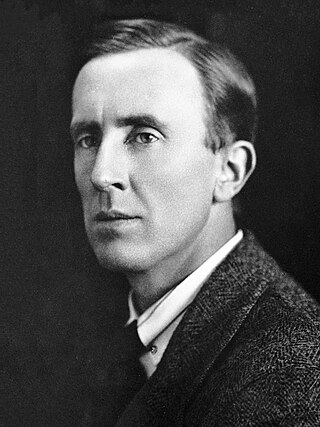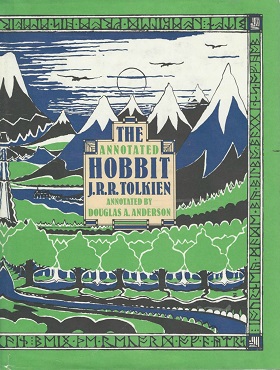
John Ronald Reuel Tolkien was an English writer and philologist. He was the author of the high fantasy works The Hobbit and The Lord of the Rings.
Treebeard, or Fangorn in Sindarin, is a tree-giant character in J. R. R. Tolkien's The Lord of the Rings. He is an Ent and is said by Gandalf to be "the oldest living thing that still walks beneath the Sun upon this Middle-earth." He lives in the ancient Forest of Fangorn, to which he has given his name. It lies at the southern end of the Misty Mountains. He is described as being about 14 feet in height, and in appearance similar to a beech or an oak.

Thomas Alan Shippey is a British medievalist, a retired scholar of Middle and Old English literature as well as of modern fantasy and science fiction. He is considered one of the world's leading academic experts on the works of J. R. R. Tolkien about whom he has written several books and many scholarly papers. His book The Road to Middle-Earth has been called "the single best thing written on Tolkien".
Tolkien fandom is an international, informal community of fans of the works of J. R. R. Tolkien, especially of the Middle-earth legendarium which includes The Hobbit, The Lord of the Rings, and The Silmarillion. The concept of Tolkien fandom as a specific type of fan subculture sprang up in the United States in the 1960s, in the context of the hippie movement, to the dismay of the author, who talked of "my deplorable cultus".

The Mythopoeic Awards for literature and literary studies are given annually for outstanding works in the fields of myth, fantasy, and the scholarly study of these areas. Established by the Mythopoeic Society in 1971, the Mythopoeic Fantasy Award is given for "fiction in the spirit of the Inklings", and the Scholarship Award for non-fiction work. The award is a statuette of a seated lion, with a plaque on the base. It has drawn resemblance to, and is often called, the "Aslan".
The works of J. R. R. Tolkien have served as the inspiration to painters, musicians, film-makers and writers, to such an extent that he is sometimes seen as the "father" of the entire genre of high fantasy.
Do not laugh! But once upon a time I had a mind to make a body of more or less connected legend, ranging from the large and cosmogonic to the level of romantic fairy-story... The cycles should be linked to a majestic whole, and yet leave scope for other minds and hands, wielding paint and music and drama. Absurd.

The Mythopoeic Society (MythSoc) is a non-profit organization devoted to the study of mythopoeic literature, particularly the works of J. R. R. Tolkien, Charles Williams, and C. S. Lewis. These men were all members of The Inklings, an informal group of writers who met weekly in Lewis' rooms at Magdalen College, Oxford, from the early 1930s until late 1949.
The Elvish Linguistic Fellowship is a "Special Interest Group" of the Mythopoeic Society devoted to the study of J. R. R. Tolkien's constructed languages, headed by the computer scientist Carl F. Hostetter. It was founded by Jorge Quiñónez in 1988.
The works of J. R. R. Tolkien have generated a body of research covering many aspects of his fantasy writings. These encompass The Lord of the Rings and The Silmarillion, along with his legendarium that remained unpublished until after his death, and his constructed languages, especially the Elvish languages Quenya and Sindarin. Scholars from different disciplines have examined the linguistic and literary origins of Middle-earth, and have explored many aspects of his writings from Christianity to feminism and race.
Wayne Gordon Hammond is an American scholar known for his research and writings on the works of J. R. R. Tolkien.
Christina Scull is a British researcher and writer best known for her books about the works of J. R. R. Tolkien, in collaboration with her husband Wayne G. Hammond who is also a Tolkien scholar. They have jointly won Mythopoeic Scholarship Awards for Inklings Studies five times.

The Road to Middle-Earth: How J. R. R. Tolkien Created a New Mythology is a scholarly study of the Middle-earth works of J. R. R. Tolkien written by Tom Shippey and first published in 1982. The book discusses Tolkien's philology, and then examines in turn the origins of The Hobbit, The Lord of the Rings, The Silmarillion, and his minor works. An appendix discusses Tolkien's many sources. Two further editions extended and updated the work, including a discussion of Peter Jackson's film version of The Lord of the Rings.
Janet Brennan Croft is an American librarian and Tolkien scholar, known for her authored and edited books and journals on J. R. R. Tolkien's Middle-earth fantasy.

The Annotated Hobbit: The Hobbit, or There and Back Again is an edition of J. R. R. Tolkien's novel The Hobbit with a commentary by Douglas A. Anderson. It was first published in 1988 by Houghton Mifflin Harcourt, Boston, in celebration of the 50th anniversary of the first American publication of The Hobbit, and by Unwin Hyman of London.

The Tolkien Society is an educational charity and literary society devoted to the study and promotion of the life and works of the author and academic J. R. R. Tolkien.

Tolkien: Maker of Middle-earth is a 2018 art book exploring images of the artwork, illustrations, maps, letters and manuscripts of J. R. R. Tolkien. The book was written by Catherine McIlwaine, Tolkien archivist at the Bodleian Library. It was timed to coincide with an exhibition of the same name, also curated by McIlwaine.
Commentators have compared Peter Jackson's 2001–2003 The Lord of the Rings film trilogy with the book on which it was based, J. R. R. Tolkien's 1954–1955 The Lord of the Rings, remarking that while both have been extremely successful commercially, the film version does not necessarily capture the intended meaning of the book. They have admired Jackson's ability to film the long and complex work at all; the beauty of the cinematography, sets, and costumes; the quality of the music; and the epic scale of his version of Tolkien's story. They have, however, found the characters and the story greatly weakened by Jackson's emphasis on action and violence at the expense of psychological depth; the loss of Tolkien's emphasis on free will and individual responsibility; and the replacement of Frodo's inner journey by an American monomyth with Aragorn as the hero.

Glen GoodKnight (1941–2010) was the founder of the Mythopoeic Society and the editor of its journal, Mythlore between 1970 and 1998; in that time the publication grew from being a fan magazine to a peer-reviewed academic journal. He was an expert on and collector of the works of J. R. R. Tolkien and his fellow Inklings, C. S. Lewis and Charles Williams.
John Garth is a British journalist and author, known especially for writings about J. R. R. Tolkien including his biography Tolkien and the Great War and a book on the places that inspired Middle-earth, The Worlds of J. R. R. Tolkien. He won a 2004 Mythopoeic Award for Scholarship for his work on Tolkien. The biography influenced much Tolkien scholarship in the subsequent decades.

The Worlds of J. R. R. Tolkien: The Places that Inspired Middle-earth is a 2020 non-fiction book by the journalist and Tolkien scholar John Garth. It describes the places that most likely inspired J. R. R. Tolkien to invent Middle-earth, as portrayed in his fantasy books The Hobbit and The Lord of the Rings. Those places include many that Tolkien lived in or visited in his early life, as well as sites from history and literature. Most are real, for instance with England as the counterpart of the Shire, though some, like Atlantis, are mythical, and others, like Mirkwood, probably have roots in real places. He notes the ambiguities in some of the connections, and that others have made superficial comparisons, such as of Tolkien's towers with various modern towers in Birmingham, where Tolkien lived as a child. Garth presents his theories of the likely origins of some of these places, supporting these with maps and photographs.













